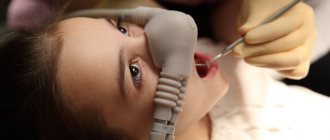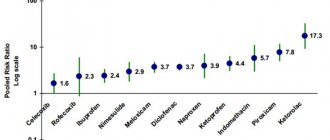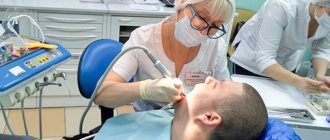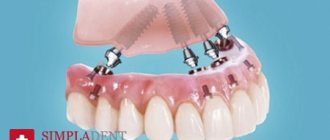Small concentrations of nitrous oxide cause a feeling of intoxication (hence the name “laughing gas”) and slight drowsiness. Nitrous oxide does not cause respiratory irritation. Nitrous oxide dissolved in blood plasma practically does not change, is not metabolized and does not bind to hemoglobin. After inhalation ceases, it is excreted (within 10-15 minutes) through the respiratory tract unchanged.
Inhalation of nitrous oxide with oxygen occurs using a comfortable mask, a pleasant aroma and a feeling of relaxation are felt. This procedure is completely safe, since nitrous oxide does not cause side effects or addiction, allergic reactions, is quickly and easily removed from the body, and has no aftereffects. This technology is used in both pediatric and adult dentistry. Nitrous oxide has been used in countries with progressive dentistry for more than 30 years. In the USA, Israel, and Great Britain, almost 100% of pediatric dental clinics use this technique on a daily basis. Therefore, it cannot be called new, but rather proven.
How is nitrous oxide used in dentistry?
Nitrous oxide, or laughing gas, as it is popularly called, was invented at the end of the 18th century by physicist John Priestley. For a long time, the invention could not be used: the gas with a pronounced sweetish taste was absolutely useless at first glance, but had a number of interesting properties. After inhalation, the person became cheerful, relaxed and experienced a feeling similar to intoxication. As usually happens, fans of this gas, or rather, its effects, quickly appeared. Nitrous oxide was used by clowns and circus performers to further excite and make the audience laugh. Over time, another interesting property was discovered: while under the influence of laughing gas, people did not seem to feel pain and treated it quite calmly. Dentist Horace Wells was the first to use nitrous oxide in dental treatment. Despite the fact that the first experiments gave positive results, public experiments were unsuccessful, and in one case the patient almost died. His colleague Wells Morton was more successful in using nitrous oxide, so he is considered a pioneer in this field. Of course, in the past, the gas formula and dosage were far from perfect, so treatment with nitrous oxide was not so predictable. In its modern version, sedation with nitrous oxide has been carried out since the late 40s. It was then that doctors began adding oxygen to the mixture and using special devices, including cylinders, a rotameter and a mask.
Sedation with nitrous oxide and oxygen mixture. “Recipe for fear” or “evil poison”?
21.09.2014 Information from Network No. 1:
“If you want to have a good laugh, you don’t have to smoke weed. Nitrous oxide is better than any drug - it’s hard to stop laughing.”
Such revelations are often accompanied by eloquent videos that leave the outside observer with a mixed feeling of shame and fear for young people who mutilate themselves. Of course, the response to the spread of the “new high” is other statements.
Information from Network No. 2:
“There was such substance abuse before the revolution. Supposedly laughing gas and all that. Abortions were performed under nitrous anesthesia until the 1970s. Any anesthesia is not free: brains die catastrophically. That’s why they gave up this anesthesia.”
But here is information from encyclopedic and educational portals, which, unfortunately, are ignored by both drug addicts and ardent persecutors of the “cursed potion”.
Information from Network No. 3:
“Laughing gas has been used medicinally as an agent used in anesthesiology and a range of medical procedures to reduce pain for over 140 years. It is part of “anesthetic cocktails” used in dentistry, obstetrics and surgery. Laughing gas relieves anxiety, improves mood, reduces pain, and leads to a state of euphoria. The rapid achievement of euphoria turned laughing gas into a popular drug at all kinds of youth parties. But not everyone knows that the use of laughing gas can produce irreversible effects on the brain and nervous system. Even with a small concentration, it disorganizes mental activity, makes it difficult for muscles to work, and impairs vision and hearing.”
Information from Network No. 4:
“Sedation is a drug-induced suppression of consciousness in which the patient responds to verbal commands with or without mild tactile stimulation.”
So is nitrous oxide sedation with an oxygen mixture, which relatively recently began to make its way into domestic dentistry, dangerous? This inexpensive and effective alternative to general anesthesia has become firmly established in dental practice in many developed countries of the world: the USA, Germany, France, Austria, Australia and others. However, for some reason we did not use it. In Russia, as well as throughout the world, anesthesia using nitrous oxide is widespread. It is used in surgical practice, operative gynecology, surgical dentistry, for pain relief during childbirth, as well as for the relief of pain attacks in acute coronary insufficiency, myocardial infarction, acute pancreatitis and other pathological conditions accompanied by pain that is not relieved by conventional painkillers.
Today, when sedation with nitrous oxide with an oxygen mixture has finally appeared in many private dental clinics and successfully helps relieve stress, fear, increased gag reflex, etc., a wave of negativity with stories about the dangers of nitrous oxide and nitrous addicts threatens to “tarnish the reputation” proven remedy. Let's figure out what's true and what's just panic. Let's turn to specialists for whom working with nitrous oxide-oxygen sedation is normal medical practice.
Klebanova N.G., anesthesiologist-reanimatologist, employee of the Russian Children's Clinical Hospital, work experience - more than 15 years:
– It is hardly worth repeating the axiom that almost any chemical substance can become a subject of addiction (painful addiction, use for narcotic purposes). Unfortunately, each of us knows that ordinary glue can become a drug and even cause the death of a person who uses this chemical, sold in every hardware store, for other purposes. Nitrous oxide is less harmful than regular black tea: this mixture is non-toxic to the body. Nitrous oxide does not cause respiratory irritation. Dissolving in blood plasma, nitrous oxide remains virtually unchanged and is not metabolized and does not bind to hemoglobin. After cessation of inhalation, it is excreted unchanged through the respiratory tract within 10-15 minutes. However, its improper and uncontrolled use can cause severe hypoxia (oxygen starvation of the brain and other tissues of the human body). After all, a person who breathes “pure” nitrous oxide does not receive oxygen! Anesthesia or sedation using a nitrous oxide-oxygen mixture (the ratios may vary, but in outpatient dental practice it is 30% nitrous oxide and 70% oxygen) in a medical institution is monitored not only by certified specialists, but also by monitoring equipment that does not allow the development of hypoxia.
Aleksandrovsky V.L., General Director of Dental Fantasy dental clinics, Ph.D., member of the European Federation for the Development of Pain Management in Dentistry:
– As a result of chronic abuse of nitrous oxide, the metabolism of vitamin B12 in the body may be disrupted, which will lead to certain neurological disorders. Anesthesiologists are well aware of this effect, but in their practice such effects simply cannot be observed. It is probably also worth mentioning that nitrous oxide can be purified, medical, and sometimes for technical use. In the case of thoughtless use of a technical mixture, it is basically impossible to guarantee anything.
The healthcare system of the United States and many European countries would have abandoned the use of nitrous oxide-oxygen mixture decades ago if its controlled use caused any significant harm to patients. Meanwhile, sedation with nitrous oxide and an oxygen mixture is used very widely. Wherever the patient needs to relax, get rid of anxiety and fear, and the doctor needs to reduce the dose of painkillers, to be able to comply with the technology for quality treatment, sedation using a nitrous oxide-oxygen mixture is used with excellent immediate results and an absolute minimum of consequences.
Rabinovich S. A., Vice-Rector for Academic Affairs and International Relations of Moscow State University of Medicine and Dentistry, President of the European Federation for the Development of Pain Management in Dentistry, Honored Doctor of the Russian Federation, Doctor of Medical Sciences, Professor, Head. Department of General Dentistry and Anesthesiology:
– We will talk specifically about sedation with nitrous oxide and an oxygen mixture in dentistry. The fact is that dental treatment has some differences from other medical disciplines. First of all, it is mass participation. In Russia there are 150-155 million visits to the dentist per year. The second feature is the multi-age composition of patients. These include babies in their first year of life and very elderly people. Finally, the third feature is that patients come to the dentist with concomitant diseases. Teeth may require urgent treatment in both a diabetic and a person suffering from hypertension, allergies, etc. That is why the issue of pain relief, as well as the problem of comfort of treatment, is one of the most important.
At the congress of the World Federation for Dental Pain Management (IFDAS) in early 2012, the main slogan was: “Treatment at the dentist should be comfortable.” The same topic will be on the agenda of the congress of the European Federation for the Development of Pain Management in Dentistry, which will take place in September this year in Moscow. Such attention to the issues of pain relief and comfort in dentistry is not accidental. The maxillofacial area, with which the dentist actually works, has innervation features that suggest increased pain sensitivity in this area. Psychologically, a person also perceives the head and neck area as a zone in which outside interference violates safety and possibly poses a threat to life itself. Fear and pain during a dental appointment can trigger activation mechanisms of the hypothalamic-pituitary-adrenal system, often leading patients with a complicated history to complications: cardiovascular disorders, hypertensive or diabetic crisis, etc. So, dental treatment should be comfortable, this It’s not someone’s whim, it’s a necessity, a guarantee of safety. How is this achieved? Of course, with local anesthesia. She was, is and will be. However, it has a number of contraindications (for example, allergic reactions), and it cannot relieve fear and anxiety. Anesthesia and sedation are excellent opportunities to treat a patient without stress, and if the patient is small, it is generally the only opportunity to qualitatively and radically relieve him of dental problems.
The use of nitrous oxide-oxygen mixture is one of the means of premedication or sedation during treatment. It should be emphasized here: this is a remedy. When treatment with sedation is planned, the patient brings the necessary test results to the dental clinic, from which we can learn about his condition and determine whether it is possible to treat him with sedation. In difficult cases, the patient is referred for additional consultation with an endocrinologist, cardiologist or other specialists. Of course, nothing like this can happen with uncontrolled use of nitrous oxide in a street or nightclub environment. Further: during treatment, the patient is monitored by an anesthesiologist, the patient’s blood pressure is measured, if necessary, the pulse rate is monitored, etc. The patient is in a comfortable chair, in a reclining position. If a person breathes nitrous oxide while standing, he may fall and be injured. The patient receives sedation on an empty stomach, and the club visitor most likely also took a fair dose of alcohol. It is difficult to imagine how such a mixture will affect him. A person in such a state loses control over himself, he can really harm himself and others. How many times is a person exposed to nitrous oxide if they are, say, undergoing dental treatment? Once or twice, rarely up to five times. And even then only during the period of intensive treatment. A drug addict who constantly and uncontrollably inhales nitrous oxide is exposed to it often and for a long time. Repeated, regular and uncontrolled use of any medication can lead to drug dependence. Such dependence may also occur in those who abuse nitrous oxide.
So is nitrous oxide a drug? If developing chemical dependence is considered an indispensable attribute of a drug, then no, nitrous oxide is not a drug. If we take into account psychological dependence, then drugs will include chocolate, sex, computer games and much more. However, the point is not whether nitrous oxide is considered a drug or not.
Morphine and its derivatives are the most effective painkillers known to humanity. And at the same time, it is a terrible drug that has ruined the lives of millions of unfortunate drug addicts. And, nevertheless, these terrible statistics are not a reason to exclude morphine compounds from medical practice and deprive people suffering from unbearable pain of the last opportunity to stop these pains. Medicine has always had at its disposal hundreds of medicines, which, when taken uncontrolled, became poisons or drugs. Unfortunately, sugar syrup does not save you from illness. And who said that sugar is not a drug?
And, finally, let us quote the “Resolution of the Council of the Association of European Dentists” dated May 11, 2012, which strongly recommends the wider use of sedation with nitrous oxide and an oxygen mixture in outpatient, and especially in pediatric dental practice: “The elimination of pain and fear from dental practice is the most important task of dentistry as a medical discipline. From 10% to 30% of patients (both adults and especially children) have some form of dental phobia: fear and anxiety experienced before dental treatment. A proven fact is both a significant reduction in the level of anxiety and fear, and therefore an increase in the comfort of treatment, and the safety of this type of sedation in the experienced hands of a professional.”
.
The materials of this article are taken from the newspaper “Dentistry Today”, issue No. 7 (117), 2012.
Indications for treatment under ZAX
One of the main advantages of nitrous oxide is its safety: the gas is eliminated from the body in the shortest possible time and in an unchanged state. To recover from the state of sedation, no special antidotes are required, which is very important when treating children’s teeth. After 10–15 minutes, the little patient returns to his normal life and does not feel any side effects. Dental treatment with nitrous oxide for children is carried out very often and has a number of indications.
- Fear of the dentist. Any treatment under sedation can reduce fear of the doctor. Few children are not nervous before the appointment, so sedation is an ideal procedure for relieving stress.
- Preschool age. At a very young age, the use of potent drugs and tranquilizers is prohibited or not recommended. In this regard, nitrous oxide is a better solution.
- Pronounced gag reflex. Laughing gas not only does not provoke, but even suppresses the gag reflex.
Experts recommend using nitrous oxide in dentistry for children for no more than 1 hour. During this time, a fairly large number of manipulations can be performed, including treating pulpitis or periodontitis. If longer or complex treatment is required, then it is better to split it into several stages.
Forbidden Air
Poe's cousin, George, also took part in the popularization of laughing gas when he came up with a way to liquefy it. Before that, nitrous oxide had to be carried in huge bags, it was expensive and inconvenient, especially compared to injectable analgesics - for example, morphine, which was already gaining popularity in the second half of the 19th century. Liquefied nitrous oxide took up much less space; bags were replaced by metal cylinders, which settled in dental offices for a long time. And from there they went to parties.
Nitrous oxide existed in this capacity throughout the 20th century. And if the circulation of medical nitrous oxide could still be somehow controlled, then the smaller cylinders that were used to whip cream in restaurants slipped away from this control. Therefore, it was not difficult to obtain laughing gas. In addition, it was inexpensive - for example, at an American rock festival in the 1970s, gas cost 25 cents per balloon.
The philosopher Bertrand Russell in the 15th chapter of “The History of Western Philosophy” recalls, with reference to William James (the same one with whom we began our story), the following anecdote about a certain lover of laughing gas: “Whenever he was under the influence of this gas, he knew the secret of the Universe, but when he came to his senses, he forgot it. Finally, by great effort, he succeeded in writing down this secret before the vision disappeared. Fully awake, he rushed to look at what he had written down. It was: “The smell of oil is everywhere.”
Apparently, Russell made a mistake with the source and slightly changed the quote - there is reason to believe that this is a reference to the experiments of the physician Oliver Holmes not with laughing gas, but with ether, which had nothing to do with the secret of the Universe, and for Holmes everything smelled not of oil, but turpentine. Nevertheless, it was Russell’s version that became widely known; Letov sang “eternity smells like oil,” and laughing gas, under the influence of which James studied Hegel, in addition to euphoria, can actually cause hallucinations.
Despite the ambiguity of its effects, laughing gas not only did not lose its audience - but, on the contrary, even increased it as competitors were criminalized. By the late 2000s, about 15 percent of teenagers in the United States had tried nitrous oxide at least once in their lives. And in its homeland, Great Britain, by 2016 it had become the eighth most popular drug. At least one in three people in the kingdom were personally acquainted with it - while less than a percentage of British adults took opioids. It is unknown how many consumers of laughing gas there are in Russia, although, judging by individual medical studies, they exist, and there are many of them.
There are more and more studies of the consequences of consuming laughing gas around the world - and we are learning more and more about the possible side effects, which, as it turns out, laughing gas also has. Inhalations themselves are usually harmless: the psychogenic effect of the gas wears off within five minutes, since it does not stay in the blood for long and exits back through the lungs. Although disorientation in space and possible hallucinations can, of course, lead to injuries - especially if the person is driving a car.
But “fun breaks” can also have long-term consequences. Nitrous oxide in large quantities oxidizes the cobalt in the vitamin B12 molecule and disables it. And B12, in turn, is involved in DNA synthesis. Therefore, chronic inhalations can lead to a decrease in the number of red and white blood cells in the blood. In addition, disturbances in vitamin metabolism lead to the accumulation of methylmalonic acid, which causes damage to the myelin sheaths in the spinal cord and, as a result, neurological disorders. They are often described by researchers from China: patients complain of weakness, instability of gait and goosebumps.
Amid growing demand for laughing gas, governments in several countries have decided to outlaw nitrous oxide. In 2016, the UK toughened penalties for the illegal production and sale of laughing gas (however, this again applies only to medical nitrous oxide, while “food grade” laughing gas remains readily available). Northern Ireland also passed such a law - in 2022, after the death of a fifteen-year-old teenager.
In Russia, since January 1, 2022, Federal Law No. 472-FZ “On limiting the circulation of nitrous oxide in the Russian Federation” has been in force. According to it, the production, manufacture, supply, storage, transportation and shipment of nitrous oxide for purposes other than medical, industrial or technical use are prohibited. In addition, the sale and marketing of such products is prohibited, and nitrous oxide itself is considered an “intoxicating substance.”
Contraindications
Today, nitrous oxide is used almost everywhere, and reviews of the procedure are mostly positive. This was largely because the use of this gas does not require a special license, which is required for other types of sedation using psychotropic substances. Because of this, ZAKS is sometimes taken quite lightly. Meanwhile, this procedure has an impressive number of contraindications and restrictions that must be kept in mind to avoid complications and side effects:
- the age of the patients is too young—ZAKS is not recommended for children under three years of age;
- upper respiratory tract diseases (colds, runny nose, rhinitis, sinusitis);
- adenoids;
- otitis in the acute stage;
- traumatic brain injuries (3 months or earlier before the start of treatment);
- seizures and epilepsy;
- lack of possibility of contact with a doctor - when performing ZAKS, the doctor must understand the child’s condition and reaction;
- individual manifestations of the reaction (convulsions, allergies, reverse reactions).
Side effects of ZAX are usually associated with the individual reaction of the child’s body to the components of the mixture. It happens that instead of a relaxed and calm state, we get the opposite reaction: hyperactivity, sudden movements, panic states. In this case, the gas supply should be stopped immediately, as there is a high risk of harming the child and only increasing his fear of dental treatment. If allergic reactions occur (shortness of breath, cough, redness), the doctor should also interrupt the procedure and give the patient antihistamines.
hangover cure
In the basement of the Pneumatic Institute, the young chemist Humphry Davy observed the Watt-Beddows machine and at the same time tried on himself the different gas mixtures that the machine produced (we talked about another valuable observation made by Davy in the material “Chrysopoeia of Water”). In 1800, in his book Researches, Chemical and Philosophical, Davy described the extraordinary effect of one of the gases - nitrous oxide, which he was able to isolate in its pure form: it helped him cope with a hangover. “After the third inhalation, I did not feel a headache, a pleasant excitement arose, my willpower was weakened, bright ideas quickly flashed through my mind; I walked around the room and was very excited for several minutes.”
The idea to relieve a hangover with nitrous oxide came to the chemist for a reason - he had already breathed this gas before. At the same time, he wrote, “increased muscle activity was accompanied by very pleasant sensations. <…> I laughed, staggered and tried to speak, but I couldn’t utter a word.”
Davy called nitrous oxide “laughing gas” - and this name, and at the same time the substance itself, quickly became popular among the people. Beddoes was still figuring out whether nitrous oxide helped against tuberculosis - and British nobles had already begun to hold social events where bags of laughing gas were served instead of wine and delicacies. According to contemporaries, at these parties some “ran up and down the stairs and throughout the house, saying strange things,” others “lost the feeling of their own weight,” and still others “felt like the sound of a harp.” There were also those who described the sensation as “returning from a walk in the snow to a warm room.”
In general, the entertainment that British aristocrats became addicted to in 1799 would be called either recreational drug use or substance abuse by modern people, depending on the context.
Life Made Easier: A Cure for Quarrelsome Wives is an 1830 satirical engraving of Humphry Davy administering a dose of laughing gas to a woman.
CC0
Share
No one at that time could explain exactly how nitrous oxide “has fun.” Moreover, even now this is not completely clear. Experiments on rats showed that it blocks NMDA receptors, which causes dopamine to be released in the areas of the brain responsible for pleasure. From a neurophysiological point of view, these processes should indeed be responsible for feelings of joy and positive emotions. But no one has yet experimentally confirmed this in humans. Davy and his followers did not know that the fun caused by the gas did not pass without a trace for them. Any substance that produces a feeling of pleasure can be addictive—nitrous oxide is no exception. The release of dopamine, which brings laughter and good mood, is associated with the formation of psychological addiction if it is released in certain areas of the brain. The fact that those addicted to laughing gas do not face full-blown chemical dependence has not been proven by anyone for three centuries. Although no one has provided clinical examples of chemical addiction to N2O. There are some considerations that the gas does not act strongly enough on dopaminergic pathways and neurons do not lose sensitivity from its influence: this, in theory, should abolish the withdrawal syndrome. But all this does not prevent nitrous oxide, so cheap, accessible and easy to use, from ruining addicted consumers.
Dental treatment in children with nitrous oxide: how does it work?
As already mentioned, the use of nitrous oxide occurs almost everywhere. Although the procedure is relatively simple, it should only be performed by a licensed anesthesiologist. In addition, if the clinic offers sedation services, there should also be a resuscitator on duty who can provide first aid if the need arises. The procedure begins with preparation. 10 hours before sedation you need to stop eating and come to the clinic on an empty stomach. If the child is small, then preparation for sedation is done in a playful way so as not to frighten or embarrass him. The process of sedation with nitrous oxide begins by first delivering 100% oxygen at a certain rate. Then nitrous oxide is added: its concentration ranges from 30 to 50%. Then the doctor administers local anesthesia, since the ZAX is designed to calm the child and remove stress, and pain relief is carried out separately. During the treatment process, the doctor communicates with the child, monitors his condition and, if necessary, asks him to take certain actions. After the manipulations are completed, the supply of nitrous oxide stops, and after 10–15 minutes the gas completely leaves the body.










